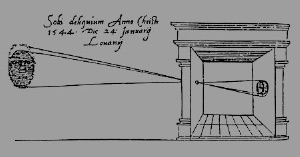Atelier Bonryu(E)
pinhole photography


Atelier Bonryu(E)
pinhole photography


Laboratory: Pinhole Photography
Applications of Pinhole Photography
- Astronomical Applications -
Astronomical Applications in Renaissance: It is pointed out that pinhole cameras played important roles for the astronomical observation during the ages of Nicolaus Copernicus (1473.2.19 - 1543.5.24), Tycho Brahe (1546.12.14 - 1601.10.24), and Johannes Kepler (1571.12.27 - 1630.11.15), who were the key figures on the path to establishment of the principle of Newton’s dynamics, i,e.,the starting point of the modern physics. As well-known Isaac Newton (1642.12.25 - 1727.3.20) discovered the principle, for which the Kepler’s law on the motion of the planets offered the most important information. And the Kepler’s law is derived on the basis of the observation data by Tycho Brahe, of whom Kepler was an assistant. Tycho Brahe, a Danish nobleman, is known to start his career as an astronomer when he observed a solar eclipse by a pinhole camera. In many books or other sources on the history of the pinhole camera we often find a picture “observation of solar eclipse (1544.1.24) by a pinhole camera ”(published as an illustration of De Radio Astronomica Et Geometrico, 1545) by Reinerus Gemma Frisius (1508.12.5 - 1555.5.25) and it is considered that Tycho Brahe and Johannes Kepler learned the technique of the pinhole camera from the book of Frisius.
Moreover, as was described previously, Kepler and Maurolico were the first in the western countries who solved the Aristotle’s problem on the pinhole phenomenon. In these ages the pinhole camera played a certain role in the observation of the sun if nothing else. Maurolico as well as Kepler didn’t solve the Aristotle’s problem purposefully to solve the problem. It was necessary for Maurolico and Kepler to solve the Aristotle’s problem on their ways to study the perspectivism and to measure the diameters of the sun and the moon by a pinhole, respectively. There are a lot of research papers on the measurement of the solar or the lunar diameters by a pinhole during Rennaisance, i.g., a paper by C. Sigismondi.
By the way it is not clear whether Copernicus was using the pinhole camera or not and it seems still a matter of argument in the field of science history. In 1900 Ludwik Antoni Birkenmajer drew an assumption that Copernicus was using the pinhole camera, and in 2006 Jarosław Włodarczyk, a Polish scientist as Copernicus, had a rethink over this problem and concluded that there is a possibility that Copernicus was using the pinhole camera.
By the way “Camera Obscura” is considered to be named by Kepler.

Observation of solar eclipse by a pinhole camera by Gemma Frisius
Astronomical Applications of the Day: In a book “Unusual Telescope” by Peter L. Manly there is a chapter “Pinhole Telescope”, where a zone plate telescope and observation of the sun by a pinhole camera are described briefly. A pinhole camera is useful for observations of the sun, especially for observations of solar eclipse and sunspots, and there are many real life examples. As it is dangerous to see the sun directly through dark glasses or black film it is recommended for an amateur to see the sun at a solar eclipse by using a “camera obscura with a pinhole lens”. In a journal “Sky & Telescope”, for example, a lot of articles on observation of the sun by using a pinhole camera are found.
Though in the above book “Unusual Telescope” it is brought on that observation of the sun by a pinhole telescope was carried out in 1980s, in a Japanese book “Observation of Sunspots (in Japanese)” published in 1969 by Ichiro Shimizu et al., there are already described a method how to make a pinhole telescope and a zone plate telescope and the photographs of sunspots taken by the pinhole telescope and the zone plate telescope. The zone plate photograph of the sunspots is sharper and clearer than the pinhole photograph because of the reason described later. On internet there are several sites which describe the pinhole application on astronomical applications such as a site by Masami Nakajima where photographs of sunspots taken by pinhole telescopes (focal length: 1700 mm and 4000 mm) are shown.
